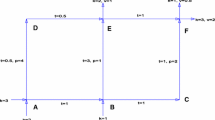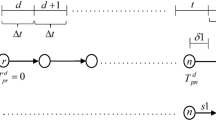Abstract
Dynamic congestion pricing has become an important research topic because of its practical implications. In this paper, we formulate dynamic second-best toll pricing (DSBTP) on general networks as a bilevel problem: the upper level is to minimize the total weighted system travel time and the lower level is to capture motorists’ route choice behavior. Different from most of existing DSBTP models, our formulation is in discrete-time, which has very distinct properties comparing with its continuous-time counterpart. Solution existence condition of the proposed model is established independent of the actual formulation of the underlying dynamic user equilibrium (DUE). To solve the bilevel DSBTP model, we adopt a relaxation scheme. For this purpose, we convert the bilevel formulation into a single level nonlinear programming problem by applying a link-node based nonlinear complementarity formulation for DUE. The single level problem is solved iteratively by first relaxing the strick complementarity by a relaxation parameter, which is then progressively reduced. Numerical results are also provided in this paper to illustrate the proposed model and algorithm. In particular, we show that by varying travel time weights on different links, DSBTP can help traffic management agencies better achieve certain system objectives. Examples are given on how changes of the weights impact the optimal tolls and associated objective function values.














Similar content being viewed by others
Notes
Note that the definition of τ iterates over 0 ≤ k ≤ K′ − 1, which corresponds to travel times at the beginning of time interval 1 to K′.
References
Arnott R, de Palma A, Lindsey R (1998) Recent developments in the bottleneck model. In: Button KJ, Verhoef ET (eds) Road pricing, traffic congestion and the environment: issues of efficiency and social feasibility. Edward Elgar, Aldershot, pp 79–110
Ban X, Liu HX, Ferris MC, Ran B (2006) A general mpcc model and its solution algorithm for continuous network design problem. Math Comput Model 43:493–505
Ban X, Liu HX, Ferris MC, Ran B (2008) A link-node complementarity model and solution algorithm for dynamic user equilibria with exact flow propagations. Transp Res Part B 42(9):823–842
Ban X, Ferris MC, Liu HX (2009) An MPCC formulation and numerical studies for continuous network design with asymmetric user equilibria. Submitted for publication
Carey M, Srinivasan A (1993) Externalities, average and marginal costs, and tolls on congested networks with time-varying flows. Oper Res 41(1):217–231
Carey M, Ge YE, McCartney M (2003) A whole-travel time model with desirable properties. Transp Sci 37(1):83–96
Chu X (1995) Endogenous trip scheduling: the henderson approach reformulated and compared with the vickrey approach. J Urban Econ 37:324–343
Clegg J, Smith M, Xiang Y, Yarrow R (2001) Bilevel programming applied to optimising urban transportation. Transp Res Part B 35(1):41–70
Dafermos S (1984) Sensitivity analysis for the asymmetric network equilibrium problem. Math Program 28:174–184
Drud AS (1992) Conopt—a large-scale grg code. ORSA J Comput 6:207–216
Facchinei F, Pang JS (2003) Finite-dimensional variational inequalities and complementarity problems, vol I, II. Springer, New York
Federal Highway Administration (FHWA) (2007) Congestion pricing. Technical report, Publication number: FHWA-HOP-07-074
Friesz TL, Bernstein D, Kydes N (2002) Dynamic congestion pricing in disequilibrium. Netw Spat Econ 4:181–202
Friesz TL, Kwon C, Mookherjee R (2007) A computable theory of dynamic congestion pricing. In: Proceedings of 17th international symposium on traffic and transportation theory, London, 23–25 July 2007
Han S (2003) Dynamic traffic modeling and dynamic stochastic user equilibrium assignment for general road networks. Transp Res Part B 37(3):225–249
Hearn DW, Ramana MV (1998) Solving congestion toll pricing models. In: Marcotte P, Nguyen S (eds) Equilibrium and advanced transportation modeling. Kluwer Academic, Dordrecht, pp 109–124
Heydecker BG, Verlander N (1999) Calculation of dynamic traffic equilibrium assignments. In: Proceedings of the european transport conferences, seminar F, pp 79–91
Kuwahara M (2007) A theory and implications on dynamic marginal cost. Transp Res Part A 41(7):627–643
Lawphongpanich S, Hearn D (2004) An mpec approach to second-best toll pricing. Math Program B 101:33–55
Liu LN, McDonald, JF (1999) Economic efficiency of second-best congestion pricing schemes in urban highway systems. Transp Res B 33:157–188
Luo ZQ, Pang JS, Ralph D (1996) Mathematical programs with equilibrium constraints. Cambridge University Press, Cambridge
Nie XJ, Zhang HM (2005) Delay-function-based link models: their properties and computational issues. Transp Res B 39:729–751
Raghunathan AU, Biegler LT (2003) Interior point method for mathematical programs with complementarity constraints. Technical report, Department of Chemical Engineering, Carnegie Mellon University
Ralph D, Wright SJ (2004) Some properties of regularization and penalization schemes for MPECs. Optim Methods Softw 19:527–556
Sumalee A (2007) Multi-concentric optimal charging cordon design. Transportmetrica 3(1):41–71
Wie BW, Tobin RL (1998) Dynamic congestion pricing models for general traffic networks. Transp Res B 32(5):313–327
Wie BW, Tobin RL, Carey M (2002) The existence, uniqueness and computation of an arc-based dynamic network user equilibrium formulation. Transp Res B 36:897–918
Yang H, Huang HJ (1997) Analysis of the time-varying pricing of a bottleneck with elastic demand using optimal control theory. Transp Res B 31:425–440
Yang H, Huang HJ (2005) Mathematical and economic theory of road pricing. Elsevier, Amsterdam
Author information
Authors and Affiliations
Corresponding author
Appendices
Appendices
1.1 Appendix 1: Definition and properties of a point-to-set map
This appendix provides definitions and properties of a point-to-set map. Interested readers may refer to Facchinei and Pang (2003) for details and proofs.
Definition 1
A map Φ is a point-to-set map from ℝn to ℝm if for any x ∈ ℝn, Φ(x) is a subset of ℝm (possibly empty). The domain of Φ, denoted by domΦ, the range of Φ, denoted by ranΦ, and the graph of Φ, denoted by gphΦ, are defined as follows:
Definition 2
A point-to-set map Φ: ℝn → ℝn is said to be
-
(a)
closed at at point \(\bar{x}\) if
$$ \begin{array}{cccc} \begin{array}{c} {x^k} \longrightarrow \bar{x}\\ y^k \in \Phi(x^k) \mbox{ } \forall k\\ {y^k} \longrightarrow \bar{y} \end{array} & \Biggr\} & \Longrightarrow & \bar{y} \in \Phi(\bar{x}) \end{array};$$ -
(b)
closed on a set S if Φ is closed at every point of S.
-
(c)
upper semicontinuous at a point \(\bar{x}\) if for every open set υ containing \(\Phi(\bar{x})\), there exists an open neighborhood \({\cal N}\) of \(\bar{x}\) such that, for each \(x \in {\cal N}\), υ contains Φ(x).
-
(d)
lower semicontinuous at a point \(\bar{x}\) if for every open set υ meeting \(\Phi(\bar{x})\), there exists an open neighborhood \({\cal N}\) of \(\bar{x}\) such that, for each \(x \in {\cal N}\), υ meets Φ(x).
Theorem 3
The following statements are true for a point-to-set map Φ.
-
(a)
Suppose \(\Phi(\bar{x})\) is a closed set. If Φ is upper semicontinuous at \(\bar{x}\) , then Φ is closed at \(\bar{x}\) ;
-
(b)
Φ is closed if and only if its graph is a closed set.
1.2 Appendix 2: Proof of Theorem 1
Under condition (b) of Theorem 1, the point-to-set mapping of SOL(y) is upper-semicontinuous (see Definition 2(c) in Appendix 1). To see this, assume \(\upsilon = SOL(\bar{y}) + IB(0,\varepsilon)\) is an open set containing \(SOL(\bar{y})\), where IB(0,ε) is an open ball with radius ε. We then define another open set \({\cal N} \equiv \{y|\|y-\bar{y}\|_2 < \delta\}\) containing \(\bar{y}\). According to condition (b) in the theorem, for any ε > 0, there exists δ > 0 such that \(\max_{\forall U \in SOL(y)} \mbox{ } \min_{\forall \bar{U} \in SOL(\bar{y})} \|U-\bar{U}\| < \varepsilon\), which is equivalent to \(\bigcup_{y \in {\cal N}}SOL(y) \subseteq \upsilon\).
Then together with condition (a), it implies that the point-to-set mapping SOL(y) is closed on set K y (see Theorem 3(a) and Definition 2(b) in Appendix 1). Therefore, the graph Φ(y, U) defined in (5) is closed (see Theorem 3(b) in the Appendix). Also under (a), SOL(y) is bounded for any y ∈ K y . Since K y is a bounded set, the graph Φ(y, U) is bounded as well. Thus, we proved that graph Φ(y, U) is compact. Together with (c) and the fact that K y is compact, BiDSBTP must has at least one solution since it is an NLP with a continuous objective function defined on a compact constraint set (i.e. from Weierstrass’ Theorem). □
Rights and permissions
About this article
Cite this article
Ban, X.(., Liu, H.X. A Link-Node Discrete-Time Dynamic Second Best Toll Pricing Model with a Relaxation Solution Algorithm. Netw Spat Econ 9, 243–267 (2009). https://doi.org/10.1007/s11067-009-9100-4
Published:
Issue Date:
DOI: https://doi.org/10.1007/s11067-009-9100-4




